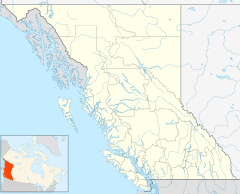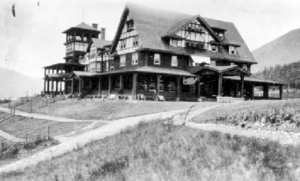Balfour, British Columbia facts for kids
Quick facts for kids
Balfour
|
|
|---|---|
|
unincorporated community
|
|
| Country | |
| Province | BC/BCE |
| Region | West Kootenay |
| Regional District | Central Kootenay |
| Area | |
| • Land | 3.72 km2 (1.44 sq mi) |
| Elevation | 571 m (1,873 ft) |
| Population
(2016)
|
|
| • Total | 459 |
| • Density | 123.4/km2 (320/sq mi) |
| Time zone | UTC−08:00 (PST) |
| • Summer (DST) | UTC−07:00 (PDT) |
| Area codes | 250, 778, 236, & 672 |
| Highways | |
Balfour is a small community in the West Kootenay area of southeastern British Columbia. It's located on the north shore where the West Arm of Kootenay Lake begins. The ferry terminal and an old steamboat stop are here. Balfour is on BC Highway 3A, about 33 kilometers (20 miles) northeast of Nelson.
How Balfour Began
For hundreds of years, First Nations people gathered huckleberries and fished in this area. In 1889, two people claimed land here. By the summer of 1890, Charles Wesley Busk, a civil engineer, opened a general store. He also planned out a townsite. The community was probably named after Arthur Balfour.
In 1891, Busk opened the Balfour House Hotel on his large fruit farm. William J. Sanders was the first postmaster from 1891 to 1892.
Busk faced financial problems and sold most of his property. In 1891, Joseph and Mary Gallup bought the store and hotel. That same year, a telephone line connected Balfour with Ainsworth and Nelson. The Anglican church opened the next year.
Around 1894, Thomas (Tom) Gregg Procter started the West Kootenay Brick Company. It used clay found about 1.6 kilometers (1 mile) from the Balfour Hotel. This company operated for about ten years. A metal factory (smelter) across the lake at Pilot Bay helped Balfour's economy. But when the smelter closed in 1896, Balfour faced a tough time for ten years. In 1897, a lighthouse was built.
Growth and Challenges
By 1907, many new people moved to the lake. They wanted to grow fruit for sale, which helped Balfour grow again. Fraser's Landing was about 2 kilometers (1.2 miles) to the west. Sydney Smyth Fraser bought land there in 1906. This spot was the western end for the Kootenay Lake Ferry from 1931 to 1947.
In 1910, Tom Procter created a new area called Riverside. It was northeast of Balfour, near the lake's exit. Riverside was on the higher ground above Balfour. That year, Edith M. Middleton became the first Balfour school teacher. Charles Holt built a log cabin that served as a general store, post office, and telephone center. Holt was the postmaster from 1914 to 1945. Later, new owners added gas pumps to the store.
The first car drove on the new Balfour–Nelson road in 1914. However, the roads were very rough until the 1930s. The road to Queens Bay was finished around 1912. The road to Kaslo was completed in 1925. A bus service from Nelson started in 1922. It went all the way to Kaslo by 1928. The bus company later became Greyhound.
A permanent schoolhouse opened in 1924 after years in a temporary building. The Great Depression started, causing the fruit farming business to struggle. After years of planning, Balfour's cemetery had its first burial in 1931. In the 1930s, a small garage with a gas pump was also built.
The CP Hotel
The Canadian Pacific Railway (CP) planned a hotel for the higher ground. It was first called Riverside but changed after people in the community protested. The Hotel Kootenay Lake opened in 1911. It had 50 rooms, beautiful gardens, and a special tramway from the lake shore. The hotel was across the west arm of the lake from where CP's boats connected to Procter and Kootenay Landing.
A tough economic time in 1913 caused the hotel to close in 1914, just as World War I began. In 1917, the building was used as a recovery home for soldiers with lung problems from the war. In 1919, Edward, Prince of Wales (who later became king) visited. The patients moved out in 1920. The building stayed empty until it was taken down in 1929.
Fun and Tourism
In 1913, Alfred H. Green bought a property with two summer cottages. He built a grand home and seven more cottages. Until 1920, people working at the soldiers' recovery home rented these cottages. From the 1920s, the whole property became a place for vacationers.
In 1947, the cottages were separated from the Balfour Beach Inn (which was Green's former home). The inn has been updated and made bigger many times over the years. The other buildings became Westlake Cottages. They operated as a resort until the land was divided into homes in the early 1980s.
In 1947, Ken and Roberta (Bobby) Chandler built the Tillicum Inn. It had a very popular restaurant. In the early 1990s, the building was expanded and became Dockers Pub. In 2007, a big renovation added more space, and it was renamed Dock 'n' Duck.
The Balfour Golf Course is located where the old CP hotel used to be. It started as a 9-hole course in 1990. In 2002, it was expanded to an 18-hole championship course. There is also an RV park and campground at the western end of Balfour.
Balfour Today
Balfour has grown to include areas like Fraser's Landing and Riverside. In 1987, all local schooling was moved to Redfish Elementary, which is to the west.
Since moving from Fraser's Landing in 1947, the western terminal for the Kootenay Lake Ferry has become the main business area. It has a bakery, a pub, a restaurant at the marina, and two retail stores. There is also a postal agency and a small supermarket that sells liquor on the highway. The supermarket moved in 1954 and has been made bigger twice since then.
Besides the British Columbia Ministry of Transportation and Infrastructure ferry terminal, Balfour is mostly a community for people who are retired or looking for a weekend getaway. The West Kootenay Transit System has bus routes 10 and 76 that stop at the ferry terminal.
The population of Balfour was 459 people in 2016. It was 477 in 2011 and 479 in 2006. In 2020, the Balfour and District Business and Historic Association bought the Anglican church building. Church services had stopped there the year before.



